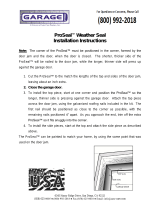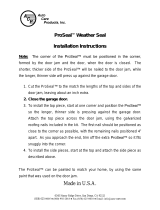
Charlotte Pipe is a registered trademark of Charlotte Pipe and Foundry Company.
FlowGuard Gold is a registered trademark of Lubrizol Corp.
4
(Updated June 9, 2020)
• Transitions from metal pipe to CPVC pipe can be made through a variety of methods such as threaded connections, flanges, and grooved
adapters. Occasionally the metal pipe may contain residual oils that were used to aid in the cutting process. Some of the oils used for this
purpose, especially those marketed as “environmentally friendly” or “vegetable based” may be incompatible with CPVC. If a cutting oil is
used, consult with the manufacturer of the cutting oils for a specific recommendation as to compatibility with CPVC.
• Dye penetrants used to test the quality of welds in metal piping may contain plasticizers or other chemicals incompatible with CPVC. Dye
penetrants left on the inside surface of welded metal pipes may later wash into CPVC piping connected to it. This situation could create
environmental stress cracking in CPVC wherever collections of the penetrant chemical might lodge. These penetrants should be removed
from the metal pipe prior to connecting to CPVC, or the manufacturer of the dye penetrant should be consulted with regard to recommending
a proper penetrant to use with metal/CPVC systems.
Paint:
• Water-based acrylic latex paint is the preferred and recommended paint to use on CPVC pipe and fittings. Oil or solvent-based
paints may be chemically incompatible.
Polyurethane (Spray-on) Foams:
• In understanding spray polyurethane foams, there are two general areas of concern for CPVC pipe and fittings; (1) chemical compatibility
and (2) potential damage to pipe and fittings due to high temperatures generated as a result of the exothermic chemical reaction during
the installation and curing process. It is possible to apply polyurethane foam insulation properly without damage to CPVC pipe and fittings.
However, the use of polyurethane foam insulation in conjunction with CPVC has resulted in the failure of CPVC pipe and fittings and property
damage. Therefore, Charlotte Pipe and Foundry does not recommend the use of polyurethane spray-on foam insulation in conjunction with
its CPVC pipe and fittings.
Residual Oils with HVAC Applications:
• Some heat exchangers or condenser coils may contain residual oils from the manufacturing process which can cause cracking of CPVC.
Caution should be exercised when installing CPVC in combination hot water/air heating units or as condensate drain lines for air conditioning
systems. Confirm the compatibility of CPVC with residual oils prior to installation. The interior of heat exchangers or the exterior of
condenser coils may be thoroughly flushed with mild detergent solution to remove incompatible oils prior to piping installation. A rinse with
clean water to completely clean the system is advisable as a final flushing.
Rubber and Flexible Materials Containing Plasticizers:
• CPVC is not compatible with some rubber and flexible vinyl materials containing certain types of plasticizers. Incompatible plasticizers
include, but are not limited to, phthalates, adipates, trimellitates, dibenzoates, etc. Compatibility should be confirmed before selecting
rubber for flexible vinyl materials for direct contact with CPVC. Examples of materials which may contain incompatible plasticizers include,
but are not limited to, caulks, rubbery hanger padding, vinyl dip coating on metal parts, rubber gaskets, electrical wire jacketing, electrical
tape, flexible hose or tube, etc. Further, plasticizers may leach from rubber or flexible vinyl materials, such as hoses or tank linings, into the
process fluid which contacts them. Plasticizer contamination in the process fluid may also cause environmental stress cracking of CPVC used
elsewhere in the system. This can include both CPVC process piping, through which contaminated fluid may flow, or CPVC ducting drawing
fumes from contaminated fluid.
Sleeving Materials:
• In situations where sleeving is required, the pipe should be protected with a compatible sleeving material extending at least 12" above and
below the soil. The top of the sleeving should be securely taped to the pipe with a compatible tape product. Backfill over underground piping
prior to termiticide spraying.
Spray-on Coatings:
• Certain types of spray-on coatings which form a peelable film to protect fixtures during construction may be incompatible with CPVC. Care
should be used to protect exposed piping from overspray when this type of protective coating is applied.
Steel Pipe with Antimicrobial Coating:
• Contractors should not use steel pipe with antimicrobial coating, such as Allied's ABF 11, in conjunction with CPVC pipe and fittings, unless
the factory-applied coated steel pipe has been approved by the pipe manufacturer.
Teflon
®
Tape:
• Charlotte Pipe
®
recommends Teflon tape as the preferred thread sealant.
Termiticides and Insecticides:
• When performing an under-slab installation, or where the presence of insecticides or termiticides is likely, care should be taken to isolate
CPVC pipe from direct contact with large quantities of these chemicals. Vinyl piping materials such as PVC or CPVC may be damaged when
termiticides or insecticides are injected into the annular space between the pipe wall and sleeving material trapping the termiticide against
the pipe wall. Termiticide applications per label instructions in an open-air environment, such as slab pretreat applications, should not pose
a problem. However, puddling of termiticides on or near CPVC may cause failure. In areas where puddling is more likely, such as near tub
boxes and retreat applications, extra care should be taken to avoid puddling of termiticides. Exercising caution and common sense should
prevent installation problems. For more information, review your manufacturer’s installation guide.
• Additional precautions need to be taken when retreat applications are required. Termiticide retreatment is usually required when the
concrete slab has been broken to relocate a pipe. The following recommendations should be followed in retreat applications:
- Remove all the plastic barrier material that was installed prior to the initial concrete pour from the area to be retreated. Do not reinstall
the plastic barrier material.
- After the pipe has been relocated, the soil should be pretreated before it is placed in hole around the pipe. Do not apply termiticide directly
to the retreat area.
- Termiticides that contain cypermethrin should not be used in retreat applications.
• Note: Many insecticides and termiticides are incompatible with CPVC. Assume that all are aggressive and not compatible with FlowGuard
Gold CPVC pipe and fittings.
• When installing CPVC where the presence of insecticides or termiticides is likely, confirm compatibility prior to application. Exercise
caution. For more information, review your manufacturer’s installation guide.
Installation Notes:
• Use CTS CPVC male threaded adapters for cold water only.
• Protect CPVC from long term exposure to direct sunlight.
• Space CPVC more than 6 inches from gas flue.
• Allow for thermal expansion and contraction.











